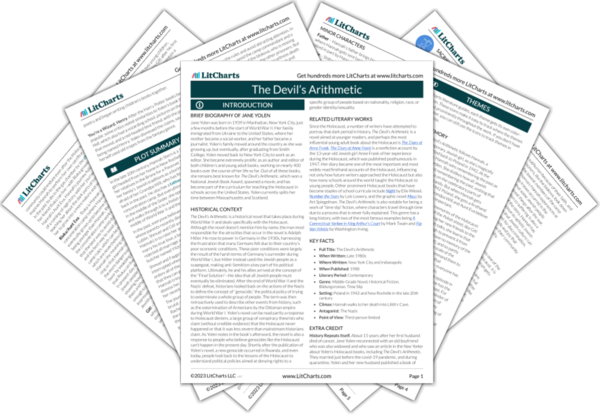Brief Biography of Jane Yolen
Jane Yolen was born in 1939 in Manhattan, New York City, just a few months before the start of World War II. Her family immigrated from Ukraine to the United States, where her mother became a social worker, and her father became a journalist. Yolen’s family moved around the country as she was growing up, but eventually, after graduating from Smith College, Yolen moved back to New York City to work as an editor. She became extremely prolific as an author and editor of both children’s and young adult books, working on nearly 400 books over the course of her life so far. Out of all these books, she remains best known for The Devil’s Arithmetic, which won a National Jewish Book Award, spawned a movie, and has become part of the curriculum for teaching the Holocaust in schools across the United States. Yolen currently splits her time between Massachusetts and Scotland.
Historical Context of The Devil’s Arithmetic
The Devil’s Arithmetic is a historical novel that takes place during World War II and deals specifically with the Holocaust. Although the novel doesn’t mention him by name, the man most responsible for the atrocities that occur in the novel is Adolph Hitler. He rose to power in Germany in the 1930s, harnessing the frustration that many Germans felt due to their country’s poor economic conditions. These poor conditions were largely the result of the harsh terms of Germany’s surrender during World War I, but Hitler instead used the Jewish people as a scapegoat, making anti-Semitism a key part of his political platform. Ultimately, he and his allies arrived at the concept of the “Final Solution”—the idea that all Jewish people must eventually be eliminated. After the end of World War II and the Nazis’ defeat, historians looked back on the actions of the Nazis to define the concept of “genocide,” the political policy of trying to exterminate a whole group of people. The term was then retroactively used to describe other events from history, such as the extermination of Armenians by the Ottoman empire during World War I. Yolen’s novel can be read partly a response to Holocaust deniers, a large group of conspiracy theorists who claim (without credible evidence) that the Holocaust never happened or that it was less severe than mainstream historians claim. As Yolen notes in the book’s afterword, the novel is also a response to people who believe genocides like the Holocaust can’t happen in the present day. Shortly after the publication of Yolen’s novel, a new genocide occurred in Rwanda, and even today, people look back to the lessons of the Holocaust to understand political policies aimed at denying rights to a specific group of people based on nationality, religion, race, or gender identity/sexuality.
Other Books Related to The Devil’s Arithmetic
Since the Holocaust, a number of writers have attempted to portray that dark period in history.
The Devil’s Arithmetic is a novel aimed at younger readers, and perhaps the most influential young adult book about the Holocaust is
The Diary of Anne Frank.
The Diary of Anne Frank is a nonfiction account by the 13-year-old Jewish girl Anne Frank of her experience during the Holocaust, which was published posthumously in 1947. Her diary became one of the most important and most widely read firsthand accounts of the Holocaust, influencing not only how future writers approached the Holocaust but also how many schools around the world taught the Holocaust to young people. Other prominent Holocaust books that have become staples of school curricula include
Night by Elie Wiesel,
Number the Stars by Lois Lowery, and the graphic novel
Maus by Art Spiegelman.
The Devil’s Arithmetic is also notable for being a work of “time slip” fiction, where characters travel through time due to a process that is never fully explained. This genre has a long history, with two of the most famous examples being
A Connecticut Yankee in King Arthur’s Court by Mark Twain and
Rip Van Winkle by Washington Irving.
Key Facts about The Devil’s Arithmetic
-
Full Title: The Devil’s Arithmetic
-
When Written: Late 1980s
-
Where Written: New York City and Indianapolis
-
When Published: 1988
-
Literary Period: Contemporary
-
Genre: Middle-Grade Novel, Historical Fiction, Bildungsroman, Time Slip
-
Setting: Poland in 1942 and New Rochelle in the late 20th century
-
Climax: Hannah walks to her death into Lilith’s Cave.
-
Antagonist: The Nazis
-
Point of View: Third-person limited
Extra Credit for The Devil’s Arithmetic








